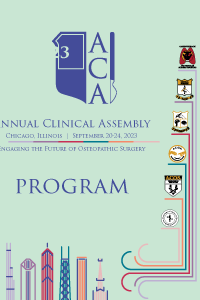General Surgery
Patients, Pandemic(s) and Policies: Enabling Local, Data-Driven Decisions for General Surgeons in COVID and Beyond
- EG
Evan G. Guay, DO, PhD
Resident
McLaren Greater Lansing/Michigan State University
Lansing, MI, United States
Primary Presenter(s)
The outbreak of SARS COVID-19 jarred our national healthcare system, leading the American College of Surgeons to release guidelines aimed at postponing elective surgeries. These recommendations were adopted by facilities throughout the country, including our own. While recent studies by such groups as the Lancet COVID Surgery committee have begun to identify trends in surgical outcomes for patients who test positive for COVID-19, more granular data are needed to understand how COVID has influenced surgical practices and patients, and how COVID and future pandemics should influence surgical services. Questions linger about what types of operations were performed for patients with and without COVID, risks of COVID transmission to surgical patients during the pandemic, what surgical needs may have gone untreated within the community, whether pathologies differed during the pandemic, and how we should assess surgical risk-benefit decisions in pandemics. We are seeking to better understand how this played out across our network of community hospitals.
Methods or Case Description:
This is a retrospective chart review of all General Surgery operations in the electronic medical records since the Go-Live date for the hospital system, with duplicates removed. Data were parsed by date and type of surgery. Another search was conducted for COVID status of each patient within a 2-week window of either side of surgery for each patient. To provide conservative risk estimations, those who tested negative before surgery or had no test pre-op, and then tested positive within 2 weeks post-op were categorized as COVID-transmission. Further searches were performed for post-op diagnoses to identify possible complications resulting from delays in presentation (“rupture”, “ischmi-“, “gangrene-“, “perforat-“, “rupture”, “abscess”, “strangulate-“, “necro-“, “leak”, “gallstone ileus”). These results were integrated, and descriptive statistics were used to analyze the data.
Outcomes: The search of General Surgeries from Feb 2020 (date of first COVID diagnosis at our hospital) to Jan 2021 produced 14,742 General Surgery cases. Once duplicates were removed, this number was brought to 14,278 unique surgeries. The search from the Go-Live date of the electronic medical record to the first COVID diagnosis to produced 7,628 General Surgery cases, which served as a baseline comparison for COVID-era data. 28 surgeries involved patients with a positive COVID diagnosis within 2 weeks before or after the surgery. 5 patients with a negative diagnosis or no known results pre-op subsequently tested positive for COVID within two weeks following surgery. Data plotted across time revealed an immediate drop in General Surgery cases following the policy to postpone elective surgeries, from 370 cases in March, to 84 cases in April. Interventions with the greatest decline following the moratorium were endoscopic procedures and hernia repairs. The most common surgeries performed on COVID+ patients include tracheostomies, enteric tubes, and wound debridement. There was a 0.035% chance of a patient catching COVID during a General Surgery encounter in this network of community hospitals, with hospital-specific rates ranging from 0% to 0.18%. Searches of post-op diagnoses show a mixed picture, suggesting insufficient power of this study to detect rare pathologies (e.g. gallstone ileus) or that patients continued to present for emergency services as needed.
Conclusion:
The sharp drop-off in cases suggests that approximately 275 operations, or ~87% of General Surgery cases within the hospital, were postponed or permanently canceled during April 2020. This a conservative estimate, as surgeries were already down 25% from previous years. Knowing the risk of COVID transmission during General Surgery encounters has facilitated informed decisions for patients, surgeons, and other medical professionals regarding whether to proceed or postpone elective or semi-elective cases, including those at the highest risk of complications from COVID. Hospitals and providers should provide similar, rolling risk calculators -- that account for local conditions within specific departments – when crafting policies for future pandemics.
This research was deemed non-human subjects by McLaren IRB, and the project was approved by McLaren’s Scholarly Activity Review Committee.

